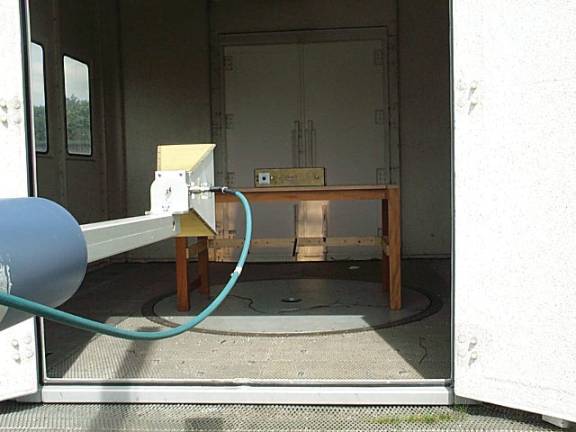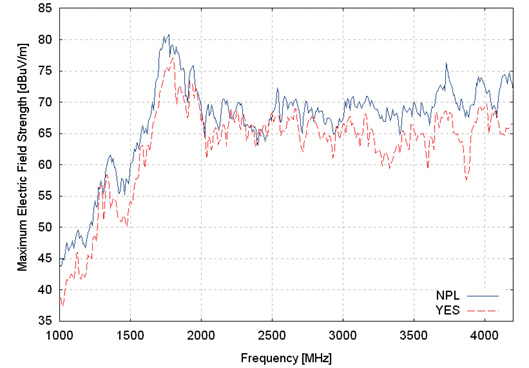|
A Study on Emission and Immunity Measurements in GTEM Cells above 1 GHz
By Martin Alexander and Angela Nothofer, National Physical Laboratory (NPL) Andrew Marvin and Didier Bozec, York EMC Services Ltd. (YES) Roger Dixon and John Wombwell, GTEM User’s Group
The Gigahertz TEM cell is a popular alternative test facility for EMC testing. Being a screened enclosure its original attractiveness was for immunity testing below 1 GHz, but it can equally be used for emission testing. The main attraction of GTEM cells is that they are less costly than anechoic chambers and require less real estate than open area test sites. An IEC standard has recently been approved that gives methods of EMC testing in GTEM cells up to 1 GHz, IEC 61000-4-201. But with increasing clock speeds of processors, there are now pressing demands for methods above 1 GHz. GTEM cells are overmoded above approximately 100 MHz, and become dramatically more overmoded at higher frequencies.
Fig 1 Schematic layout of a GTEM cell
A project to investigate the usability of GTEM cells for EMC conformance testing above 1 GHz was sponsored by the DTI’s National Measurement System Policy Unit. The work was jointly carried out by NPL and YES between October 2001 and December 2002, with input from the UK GTEM Users’ Group. The aim of the project was to support UK industry by quantifying and reducing measurement uncertainties in the use of GTEM cells in EMC testing. A Best Practice Guide on the use of GTEM cells and measurement uncertainties is being written, available in April 2003.
Fig. 2 Measurement of REUTE up to 6 GHz on YES OATS at 3m distance
This project just covered a subset of applications since there was only time to investigate one Realistic EUT for Emission (with 3 different radiating modes) and one REUT for Immunity, both designed and made by YES. The figures show emission measurements of the REUTE in the NPL 1750 GTEM cell and in the YES 1100 GTEM cell up to 4.2 GHz. The REUTI contained an electro-optic sensor to monitor the susceptibility level. The results of NPL and YES were in good agreement, indicating that the performance of the EUT was not significantly affected by being within the GTEM metal enclosure.
Fig.3 The three orientations of the REUTE for the emission measuements
Fig. 4a NPL & YES GTEM results, correlated for 10m OATS, for REUTE in Slot and gap mode, up to 2 GHz
Fig 4b NPL & YES GTEM results, correlated for 10m OATS, for REUTE in slop and gap mode, from 1 GHz to 4.2 GHz
A workshop was held on 25 September which attracted 36 attendees, including many who are members of the UK GTEM User Group. There was a presentation on work done at NPL to suppress the longitudinal field which can put some cells out of specification. This unwanted mode can be reduced by laying a small area of ferrite tiles on the floor of the cell and/or by improving the termination of the cell2. Measurement results were shown, and these are summarised in a paper presented at EMC Zurich3. The general conclusion was that the overall uncertainty of radiated emission testing in GTEM cells for products without cables, was around ± 5 dB, not too different from other types of test facility, the 10 m open area test site being the CISPR standard. The cells are basically useable to higher frequencies. More work is needed to explore the usability of EUTs of different sizes and with mains and data cables connected to them. Two meetings were held with the GTEM Users group who voiced the needs of users of GTEM cells and who helped by one member repeating the measurements. These results lay within the range of NPL and YES results, adding confidence to these results, but demonstrating that a spread of up to 10 dB at some frequencies is not untypical.
References: 1 IEC 61000-4-20: Electromagnetic compatibility: Testing and measurement techniques - Emission and immunity testing in transverse electromagnetic (TEM) waveguides. 2 Loader, B.G., Alexander M.J., Blackburn J., The longitudinal field in the GTEM 1750 cell and the nature of the termination, EuroEMC, Sorrento, September 20 3 A. Nothofer, M.J. Alexander, D. Bozec, D. Welsh, L. Dawson, L. McCormack, A.C. Marvin, A GTEM Best Practice Guide – applying IEC 61000-4-20 to the use of GTEM cells, Zurich EMC Symposium, February 2003.
|




